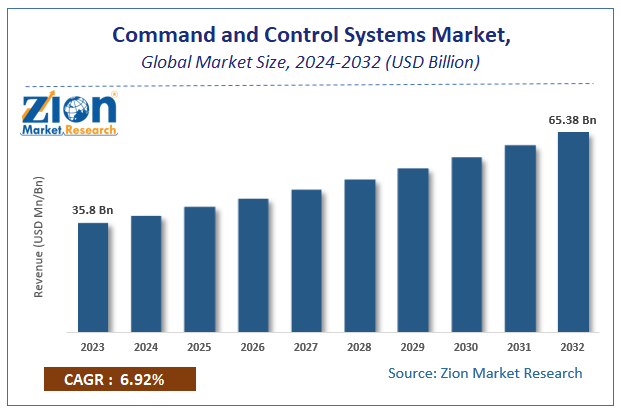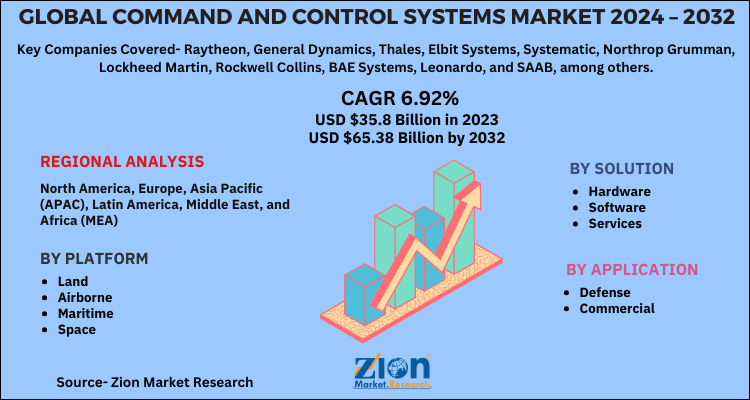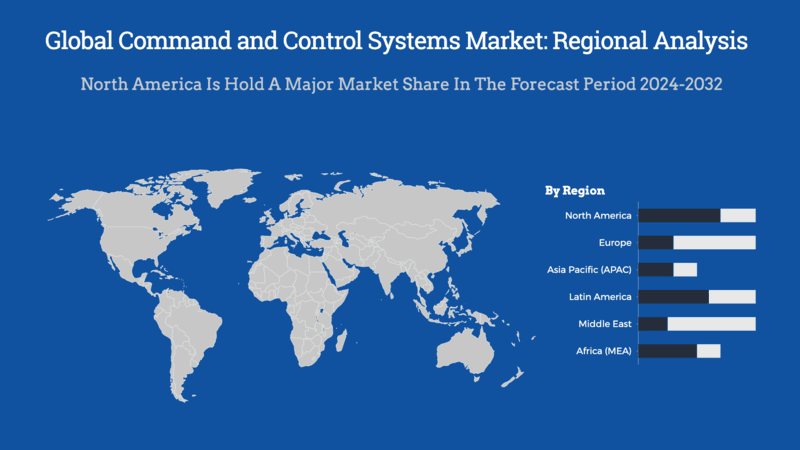Command and Control Systems Market Size, Share, Analysis, Trends, Growth, 2032

Command and Control Systems Market- by Application (Commercial, Defense), by Solution (Services, Hardware, Software), by Platform (Airborne, Maritime, Land, Space) - Global Industry Perspective Comprehensive Analysis and Forecast, 2024 - 2032
| Market Size in 2023 | Market Forecast in 2032 | CAGR (in %) | Base Year |
|---|---|---|---|
| USD 35.8 Billion | USD 65.38 Billion | 6.92% | 2023 |
Command and Control Systems Market Insights
Zion Market Research has published a report on the global Command and Control Systems Market, estimating its value at USD 35.8 Billion in 2023, with projections indicating that it will reach USD 65.38 Billion by 2032. The market is expected to expand at a compound annual growth rate (CAGR) of 6.92% over the forecast period 2024-2032. The report explores the factors fueling market growth, the hitches that could hamper this expansion, and the opportunities that may arise in the Command and Control Systems industry. Additionally, it offers a detailed analysis of how these elements will affect market demand dynamics and market performance throughout the forecast period.
Global Command and Control Systems Market: Overview
C2 or command and control is a widely used the term in the military system. Based on the definition given by the military scientists, C2 is a set of technical and organizational attributes and processes that employ the physical, human, and information resources to solve the problems and finish the missions.
Global Command and Control Systems Market: Growth Factors
The escalating requirement to improve military, law enforcement, military, utilities, and the manufacturing industries owing to the increasing terrorist activities are driving the growth of the command and control systems market. Growing geopolitical conflicts among the regions also contribute to the increased demand for command and control systems. There is increased use of the C2 technology in the commercial and defense sectors as command centers help in bringing together different disciplines and create an interconnection between them to carry out the operations smoothly. In regions such as the Asia Pacific, introduction to the next-gen defense technologies and increased military spending are other factors increasing the demand for the command and control systems market.
These systems are extensively used for controlling world terror activities and in managing military operations around the world. Moreover, growing awareness about the technological benefits such as information exchange, situation assessment, and operational control is triggering the growth of the global command and control systems market. The commercial sector also contributes to an increased demand for the command and control systems in order to manage the vital operations. The commercial end-users for the command and control systems are power plants, research labs, manufacturing plants, oil and gas installation plants, airports, and others.
Key Insights
- As per the analysis shared by our research analyst, the global Command and Control Systems Market is estimated to grow annually at a CAGR of around 6.92% over the forecast period (2024-2032).
- In terms of revenue, the global Command and Control Systems Market size was valued at around USD 35.8 Billion in 2023 and is projected to reach USD 65.38 Billion by 2032.
- Based on the Application, The government & Defense this segment leads the market, accounting for approximately 39.8% of the market share in 2024. The prominence of this segment is due to the critical role command and control systems play in military operations, providing real-time situational awareness, secure communication, and strategic coordination across various defense branches
- Based on the Solution, Hardware solutions constitute the largest market segment. This includes essential physical components such as high-performance servers, data centers, ruggedized computers, and communication equipment necessary for the effective operation of command and control systems. These components facilitate data processing, communication, and user interaction, which are vital for mission-critical applications.
- Based on the Platform, The land segment dominates the platform category, holding approximately 37% of the market share in 2024. This dominance is driven by significant investments in modernizing ground-based command and control capabilities, including battlefield management systems and tactical communication infrastructures aimed at enhancing situational awareness and decision-making in terrestrial operations.
- Based on the Region, North America leads the global command and control systems market, with a market share exceeding 41.7% in 2024. This leadership is attributed to substantial investments in defense and commercial initiatives, advanced defense industrial bases, and a strong focus on integrating advanced communication technologies to ensure operational security and effectiveness.
Command and Control Systems Marke: Dynamics
Key Growth Drivers
The command and control systems market is experiencing significant growth driven by the increasing need for advanced situational awareness and decision-making capabilities across defense, aerospace, and commercial sectors. Governments worldwide are investing heavily in modernizing military infrastructure, leading to a surge in demand for sophisticated command and control systems. The integration of emerging technologies like artificial intelligence (AI), big data analytics, and cybersecurity solutions enhances the effectiveness of these systems. Additionally, the growing emphasis on homeland security, disaster management, and border control further supports market expansion. The proliferation of smart city initiatives and the rising adoption of unmanned systems also contribute to market growth.
Restraints
Despite the favorable growth drivers, the command and control systems market faces certain restraints, including the high costs associated with developing and maintaining these complex systems. Budget constraints in developing countries may limit the widespread adoption of advanced command and control technologies. Furthermore, interoperability challenges between legacy systems and new technologies can hinder seamless data sharing and operational effectiveness. Cybersecurity concerns also pose a significant restraint, as command and control systems are often targeted by cyberattacks, necessitating continuous investments in robust security measures.
Opportunities
The increasing adoption of cloud computing and edge computing solutions presents notable opportunities for the command and control systems market. Cloud-based platforms enable real-time data analysis and decision-making, making systems more agile and efficient. The rise of 5G technology further enhances communication capabilities, offering opportunities for rapid information exchange in defense and commercial applications. Additionally, the growing demand for integrated command and control systems in the transportation, energy, and healthcare sectors opens new avenues for market growth. Collaborations between governments and technology providers for the development of smart defense infrastructure also create significant growth opportunities.
Challenges
One of the key challenges in the command and control systems market is the complexity of integrating and managing vast amounts of data from multiple sources. Ensuring accurate data interpretation and timely decision-making in high-pressure scenarios remains a challenge. Additionally, the reliance on global supply chains for critical components may lead to disruptions, impacting the timely delivery and deployment of systems. Regulatory and compliance issues across different regions can further complicate market expansion. Moreover, as cyber threats evolve, ensuring the continuous cybersecurity resilience of command and control systems remains an ongoing challenge for organizations and governments alike.
Command and Control Systems Market: Report Scope
| Report Attributes | Report Details |
|---|---|
| Report Name | Command and Control Systems Market |
| Market Size in 2023 | USD 35.8 Billion |
| Market Forecast in 2032 | USD 65.38 Billion |
| Growth Rate | CAGR of 6.92% |
| Number of Pages | 110 |
| Key Companies Covered | Raytheon, General Dynamics, Thales, Elbit Systems, Systematic, Northrop Grumman, Lockheed Martin, Rockwell Collins, BAE Systems, Leonardo, and SAAB, among others |
| Segments Covered | By Application, By Solution By Platform And By Region |
| Regions Covered | North America, Europe, Asia Pacific (APAC), Latin America, Middle East, and Africa (MEA) |
| Base Year | 2023 |
| Historical Year | 2018 to 2022 |
| Forecast Year | 2024 - 2032 |
| Customization Scope | Avail customized purchase options to meet your exact research needs. Request For Customization |
Global Command and Control Systems Market: Segmentation
The global command and control systems market is segmented into its application, solution, and platform. All the segments have been analyzed based on present and future trends and the market is estimated from 2024 to 2032.
In terms of application, the market is bifurcated into commercial and defense applications.
Based on the solution, the command and control systems market is divided into services, hardware, and software.
Different platform for the command and control systems are airborne, maritime, land, and space.
The regional segment includes the current and forecast demand for North America, Europe, Asia Pacific, Latin America, and the Middle East and Africa.
Global Command and Control Systems Market: Regional Analysis
Majority of the command and control systems market shares is expected to be held by North America. The presence of major command and control systems providers and the swift technological developments in the region contribute to the growth of the command and control systems market. Furthermore, the U.S. is practicing collaborative international military operations with the help of local governments in the Middle East contributing to the North American command and control systems market. Another factor that contributes to the market growth in this region is the presence of vital infrastructure.
The Command and Control (C2) Systems market demonstrates varied growth patterns across different regions, influenced by factors such as defense modernization efforts, technological advancements, and geopolitical dynamics.
North America
North America is experiencing significant growth in the C2 Systems market, with a projected growth rate of nearly 6.0% from 2024 to 2030. This expansion is driven by advancements in artificial intelligence (AI), machine learning (ML), and cybersecurity, which are fostering innovations in command and control systems. The region's commitment to modernizing defense and homeland security apparatus, including the integration of cyber defense strategies, is creating substantial market opportunities. In the United States, substantial investments are being made to upgrade military capabilities with advanced technologies, contributing to a growth rate exceeding 5.0% during the same period.
Asia-Pacific
The Asia-Pacific region is anticipated to record the highest compound annual growth rate (CAGR) in the C2 Systems market from 2024 to 2030. Geopolitical tensions and border disputes have heightened the focus on national security, leading to increased demand for advanced command and control systems. Rapid urbanization and smart city initiatives further contribute to this growth. In China, a significant emphasis on developing indigenous technology and achieving self-reliance in defense technologies has positioned the country as a leader in the regional market. India is also expected to witness notable growth, driven by investments aimed at enhancing surveillance and operational capabilities amid rising border tensions. Japan's market is projected to grow at a CAGR of over 9.0%, reflecting its commitment to bolstering defense capabilities in response to national security concerns.
Europe
Europe holds a significant share of the C2 Systems market, supported by the implementation of North Atlantic Treaty Organization (NATO) standards among member states. These standards promote interoperability and modernization of military assets, including command and control systems. The European Union's investment in research and development for defense technology innovation, particularly in AI and cyber defense, further propels market growth. In the United Kingdom, adherence to NATO guidelines and sustained investment in modernizing military capabilities are driving market expansion. Germany is focusing on transforming its military infrastructure through comprehensive digitization initiatives, with an estimated CAGR of around 8% from 2024 to 2030.
Middle East and Africa (MEA)
The MEA region is anticipated to experience significant growth in the C2 Systems market from 2024 to 2030. Ongoing infrastructure projects, particularly in Gulf Cooperation Council (GCC) countries, involve the development of smart cities that require integrated command and control systems for efficient urban management, traffic control, and public safety. In Saudi Arabia, the rising demand for efficient urban management, driven by infrastructure development and smart city projects, has contributed to a considerable market share in 2023.
Latin America
In Latin America, Brazil stands out as a key market for C2 systems, holding approximately 28% of the regional market share in 2024. This dominance is attributed to comprehensive military modernization programs and significant investments in indigenous defense capabilities. Brazil's focus on developing advanced command and control systems is evident through initiatives like the SISFRON border monitoring system. The country's market is projected to grow at approximately 5% during 2024-2029, supported by ongoing modernization efforts and increased defense spending.
In summary, the global Command and Control Systems market is characterized by region-specific drivers, including defense modernization, technological innovation, and security challenges, leading to varied growth trajectories across different areas.
Global Command and Control Systems Market: Competitive Players
Among several companies in the global command and control systems market, some of the prominent players include
- Raytheon
- General Dynamics
- Thales
- Elbit Systems
- Systematic
- Northrop Grumman
- Lockheed Martin
- Rockwell Collins
- BAE Systems
- Leonardo
- SAAB
- among others.
The global command and control systems market is segmented as follows:
By platform:
- Land
- Airborne
- Maritime
- Space
By solution:
- Hardware
- Software
- Services
By application:
- Defense
- Commercial
Global Command and Control Systems Market: Regional Segment Analysis
- North America
- The U.S.
- Europe
- The UK
- France
- Germany
- The Asia Pacific
- China
- Japan
- India
- Latin America
- Brazil
- The Middle East and Africa
What Reports Provides
- Full in-depth analysis of the parent market
- Important changes in market dynamics
- Segmentation details of the market
- Former, on-going, and projected market analysis in terms of volume and value
- Assessment of niche industry developments
- Market share analysis
- Key strategies of major players
- Emerging segments and regional markets
- Testimonials to companies in order to fortify their foothold in the market.
Table Of Content
Methodology
FrequentlyAsked Questions
A Command and Control System refers to a centralized platform that enables military, government, or emergency response organizations to manage operations and make critical decisions. These systems collect, process, and distribute information in real time, allowing leaders to monitor, coordinate, and direct resources and personnel effectively. Command and control systems integrate technologies such as communication networks, data processing tools, and sensors to provide a comprehensive view of the operational environment. They are widely used in defense for battlefield management, as well as in disaster response, air traffic control, and law enforcement to ensure coordinated, efficient, and secure operations.
The rising requirement for interoperability amid security technology or devices is generating demand grip for command and control systems, thus driving the worldwide command and control market.
According to a study, the global command and control systems Industry size was $35.8 Billion in 2023 and is projected to reach $65.38 Billion by the end of 2032.
The global command and control systems market is expected to grow at a CAGR of 6.92% during the forecast period.
The North America region held the largest market share during 2023, due to rapid technological advancements and concentration of the main command and control system providers.
Among several companies in the global command and control systems market, some of the prominent players include Raytheon, General Dynamics, Thales, Elbit Systems, Systematic, Northrop Grumman, Lockheed Martin, Rockwell Collins, BAE Systems, Leonardo, and SAAB, among others.
The global command and control systems market report covers the geographical market along with a comprehensive competitive landscape analysis. It also includes cash flow analysis, profit ratio analysis, market basket analysis, market attractiveness analysis, sentiment analysis, PESTEL analysis, trend analysis, SWOT analysis, trade area analysis, demand & supply analysis, Porter’s five force analysis, and value chain analysis.
Choose License Type
List of Contents
Command and Control Systems Market InsightsGlobal Command and Control Systems OverviewGlobal Command and Control Systems Growth FactorsKey InsightsCommand and Control Systems Marke: DynamicsCommand and Control Systems Report ScopeGlobal Command and Control Systems SegmentationGlobal Command and Control Systems Regional AnalysisGlobal Command and Control Systems Competitive PlayersThe global command and control systemsmarket is segmented as follows:Global Command and Control Systems Regional Segment AnalysisWhat Reports ProvidesRelatedNews
HappyClients
Zion Market Research
Tel: +1 (302) 444-0166
USA/Canada Toll Free No.+1 (855) 465-4651
3rd Floor,
Mrunal Paradise, Opp Maharaja Hotel,
Pimple Gurav, Pune 411061,
Maharashtra, India
Phone No +91 7768 006 007, +91 7768 006 008
US OFFICE NO +1 (302) 444-0166
US/CAN TOLL FREE +1 (855) 465-4651
Email: sales@zionmarketresearch.com
We have secured system to process your transaction.
Our support available to help you 24 hours a day, five days a week.
Monday - Friday: 9AM - 6PM
Saturday - Sunday: Closed








